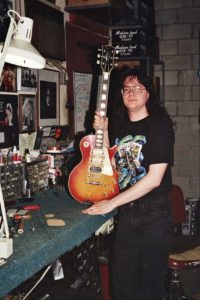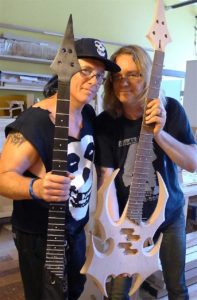Bill Baker, Guitar Tech
Bill knows a lot of people and has worked on guitars owned by Ace Frehley and Dez Cadena (The Misfits)
Who is Bill Baker?
Bill Baker, a guitar tech from New Jersey, works at Dave’s Sound Repair in Whippany, NJ. He has been fixing and playing guitars since he was a teen and has been working with Dave Hirsch his whole career. Bill is known for being former KISS guitarist Ace Frehley’s guitar tech and friend in the early ’90s and had a massive Ace collection. He fronted the Ace Frehley tribute band, Fractured Mirror. He also has the Ace Frehley Archive, a site dedicated to Ace Frehley. Further, he is known for his popular restringing video on YouTube. He has met and worked with a lot of people in the business. Bill has so many stories, so we have to do this interview in parts.
MUSICXPLORER — Bill, how did you become interested in guitars?
Bill — As a kid, I just loved music. My father had a couple of friends that played guitar and they would come over, and I would watch them and be fascinated by that. Later on, when we moved, the neighbor next door would sit out on his front porch, play bass, and jam along to records. I would watch him through the window of him playing. One time he told me to come inside and watch, and I’m like, “Well, you have got to teach me how to play.” So he gave me some lessons and kinda taught me how to get through the Eagles “Victim of Love.”
So you were learning how to play and fix guitars on your own?
Bill — Yeah, I started to take my guitars apart and put them back together. Back then you couldn’t buy a book on how to do that. I remember, I had this one guitar that didn’t work. It had these push-button switches that were very unreliable, and I sort of learned how to make a better contact using a soldering iron. So, I picked up little things like that along the way, but it wasn’t until I bought the first good guitar, a 62 reissue Strat. Demarzio. I made a stacked pickup that I put in the Strat. It kind of gave me a start on working on guitars.
When did you start to work on guitars for a living?
Bill — I walked into a music store in Morristown to get an amplifier fixed and told the owner, Dave Hirsh, that I work on guitars, and said, “I can do little repairs on guitars, if you need somebody,” and he said, “You know, maybe you could come in on Saturdays and do some things for me. I could use some help.” I started working for Dave one day a week, and then eventually turned into two days a week. Dave eventually moved to a bigger location, and I have been with him ever since.
So, you really taught yourself how to repair guitars?
Bill — Yeah, sometimes I would learn by doing. For example, somebody would come in and say, “I got a Tele and I want a Floyd Rose put in it.” I knew it was going to be difficult, and I tried to talk him out of it. I told him the guitar was going to get butchered up. He was still insistent on getting it done. I’d say to myself, “Okay, how am I going to do this?” While I had the jig to put in the Floyd Rose, I had to measure twice and cut once. I wish I had a picture of that because it was crazy to do, and stupid because it was an early seventies Tele that would be worth a pretty good buck now.


How did you start to figure out how to refret?
Bill — I was looking at other fret work jobs that other repairmen did, and I would see something that didn’t look right and I’m like, well, gee, I got to figure out a way to do this better. I saw a lot of bad refrets, and you know, there’s got to be a way to do it nice and clean. So, I decided to start on a Gibson Flying V that I had, and I refretted the guitar a few times until I got it right.
Did you go anywhere to learn how to do inlays?
Bill — I went to the Guitar Symposium that was held at the Nazareth College, sponsored by Martin. There was a guy there who was cutting pieces of Pearl, and I was like, oh, that looks kind of cool, and I always wanted to know how to do inlays. I asked about it, and he let me practice cutting up the Pearl with him. I then decided I was going to refret that Flying V one more time. I cut out musical notes, and I inlaid them going up the fingerboard.
That sounds pretty cool!
Bill — It was, and I thought that guitar was going to be wonderful and it was going to be my guitar, because it was so cool, but then I realized I didn’t like playing it cuz the way the flying V sits on your body. So I sold it.
What’s your favorite thing about repairing guitars?
Bill — Probably my favorite thing is just seeing the varieties of different guitars, especially working on really cool guitars.
What is your dream guitar?
Bill — I love Les Paul’s. So my dream guitar would be like a flame top Les Paul with super jumbo, Dunlop 6000 frets, just one humbucker, and a volume control. But, I know the Gibson Custom Shop would probably want about 10 grand for it, so I’ll never have one.
That would be nice to have though. What’s your least favorite thing?
Bill — The thing that I like the least, is working on these Chinese knockoffs. They are low-end quality and because there’s a lot of problems with them. It’s hard to get parts that fit because a lot of these companies make up their own sizes, and the work and wiring are sloppy. I got a story about that.
Yeah, you have some good ones.
Bill — And they are all true.
Somebody brought me a Chinese counterfeit Gibson and the wiring was not shielded, so the thing is really noisy. The parts are cheap, and the guy thinks he got a great deal. But when I added up how much it’s going to cost him to put in better pick ups and pots, and all new wiring, it’s gonna be more than what he just paid for the guitar. Then the fret work is no good and the nut and bridge are just awful. I started adding all the stuff up to make it, and I said, “You should have just bought a used Epiphone and you would have had a much better guitar.”
What are the Pots?
Bill — Pots are the controls. That’s short for potentiometer, in layman’s terms.
You have a couple of videos that are pretty popular on YouTube about your “Z” method for restringing guitars. There is one that has over 15,000 views. How did that come about?
Bill — Is that the high-definition one?
Yeah.
Bill — I think on the first one I did, there were over 200,000. The video I did in 2008 was with the guitar that I bought from Dez Cadena of the Misfits.
Did you also work on Doyle’s guitars?
Bill — No, but I did work on the basses that Jerry Only designed that were made by CWF in Newton.

Cool. Have you seen the controversy on your method versus the Gary Brawer method?
Bill — I forget, but I saw it.
It’s on The Gear Page.
Bill — Gear Page. Yep, you’re right, there were.
Yeah, so it was on The Gear Page in 2017, and it’s also on the Seymour Duncan and The Right Brain site. The debate is the over and under, one string at a time method, and yours.
Bill — Yeah, which I saw people call it the the “Z” method. Well, I’ll explain that.
Many years ago, Dave my boss, told me three fingers are good to wrap around the tuners. That’s what they had come up with, from when he was working at Robbie’s Music, back in the 70’s. That was kind of my rule too. When I first started playing, I had a Strat. Strats have those slotted tuners so you just kind of put it in and wrap it. I learned because of the tremolo that you had to stretch the strings out and get the slack. You couldn’t have too many wraps that couldn’t be sloppy. It had to be nice and neat.
The majority of the comments I have seen on the restringing videos are that people say that you shouldn’t take all the strings off at once because it messes with the neck.
Bill — Well, here is my opinion on that. When the guitar was made, did it have strings on it? No, it didn’t, so it’s OK to take them all off. Don’t take them all off and let the guitar sit for a couple of years, because the truss rod is pulling in the other direction. But, if you take it off for say a half hour, or an hour, or even a couple hours, or even if you have to do some major work, you have to take them all off. If you have to take them all off to clean the guitar and put the strings right back on, the guitar is going to go right back where it was. The truss rod was set for the counter tension of the strengths. Now, let’s say you had twelves on there, and you took all the strings off and you put on eights, the neck is probably going to be too straight. If you had eights on there, and you put twelves on, the neck is probably going to be a little too curved; but if you had tens and you put back on tens, then you’re going to be OK.
A Les Paul is different because of the floating bridge.
Bill — On a Les Paul, if you take all the strings off, the tail piece falls off, the bridge will fall off, and the little wheels can lose their their spot. So a safe way to play it is, change them one at a time. If you’re paranoid about anything going out of adjustment or whatever, just change them one at a time; but it makes it a little tougher to clean the guitar.
On a Strat, you wouldn’t have to worry about it.
Bill — If you have a floating tremolo on a Strat, it’s the string tension that’s causing the bridge to float. If you take them all off the bridge, it is going to lay on the face. If you have a Floyd Rose guitar and you take them all off, the Floyd Rose is going to flop onto the face or into the cavity, and it’s going to be a pain in the ass to put it back. So, what you want to do is, if you have to take them all off, and if you have a tremelo on a Strat, you could always stick a guitar pick under the back of the bridge, and it’ll keep it up where it was. You don’t really have to, but if you wanted it to be exactly where it was, you could do that.
What do you think about the other restringing method?
Bill — There’s nothing wrong with either — there are pros and cons to each one. I guess there’s really no right or wrong. It’s whatever you want to try.
What made you do the video in the first place?
Bill — The whole reason that I made that video was because when I was in my Ace Frehley tribute band, Fractured Mirror, we were going to play one last time at a KISS convention and the original guitar player, Mike, from that band showed up with his guitars, and he says, “Can you change my strings for me?” and I’m like, “Mike you’re 40 years old you can’t change your own strings?”
That’s funny!
Bill — Yeah, I told him, I should make a video, so, I said, “Okay Mike, you’re going to hold the video camera, we’re going to use your guitars, and we’re going to make a restringing video.” I then transferred it to a DVD, and sent it to my friend in Australia who runs my website and he uploaded them for me.
We are running out of time for this part of the interview. But how did you meet Ace?
Bill — I had a table at one of the KISS conventions in 1990 and this guy was asking if anyone wanted to buy one of Ace’s guitars. I said, “Sure, but I don’t have the cash on me right now.” I told him about a Marshall cabinet I was selling, and he said that we could meet at his house to trade the amp and the guitar. He also said that he could have Ace meet with us to sign the guitar since he had to bring it to his house.
Sounds pretty cool.
Bill — Yeah, and when Ace showed up, it was kind of surreal. He was pretty cool about things, and then we all went out to dinner and had Sushi.


